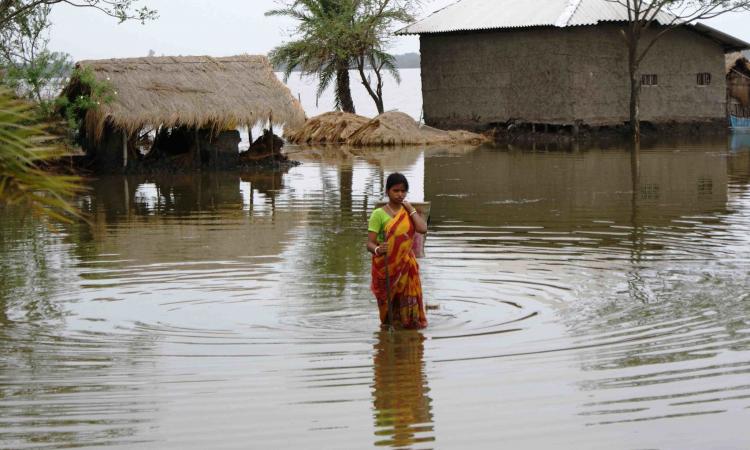
Exposure to disaster risk is often dictated by social constructs such as gender, class, race, sexual orientation, etc. The overlap and interconnectedness of these constructs are known as ‘intersectionality’. This issue of Southasiadisasters.net is titled ‘Intersectionality of Women-Led Disaster Preparedness and Resilience’ and focuses on the important aspect of women-led disaster risk reduction (DRR).
It has been observed that men and women have differentiated vulnerability to disasters. This differentiated vulnerability needs to be articulated and understood so that appropriate risk reduction policies can be implemented.
This issue tries to highlight not only women’s differentiated vulnerability but also the fact that women’s leadership in reducing risk against extreme events has been hitherto neglected. By discussing, the intersectionality of risk, resilience and gender a meaningful dialogue with concrete action can be started in this direction.
Intersectionality of Women-Led Disaster Preparedness and Resilience
During various disasters in India, the mortality of women has been higher than that of men. Pre-existing, structural gender inequalities mean that women and girls bear a disproportionate burden of the adverse impacts of disasters than men and boys. The COVID-19 pandemic has highlighted this differentiated vulnerability like never before. As the pandemic unfolds, its impacts on women's welfare, food and livelihood security are becoming increasingly clear.
The pandemic and its concomitant lockdowns have disrupted livelihoods and value chains in rural and urban areas. Women tend to experience more lingering income shocks and have greater difficulty accessing food than men. Furthermore, the pandemic is increasing the work burden on women due to school closures and the additional care needs of sick family members in the household. An increase in gender-based violence and the deteriorating mental health of women have also been noted.
Another debilitating factor is that the role of women is often ignored in risk reduction and relief contexts which in turn limits their participation in such activities.
Women’s Leadership in Humanitarian System in India: Early Findings
Women have started to assume positions of leadership at the local level. They are in a better position to present their problems and difficulties before the authorities. The trinity of women functionaries at the grassroots – ASHA, Anganwadi and ANM – deal with issues of child and female reproductive health and nutrition which assume critical importance post emergencies. These official functionaries along with the elected Panchs and Sarpanchs are involved with post-disaster need assessment at the local level.
In the cyclone-affected states of Odisha and West Bengal majority of local-level committees to manage shelter camps were led by women. Similar trends were beginning to be noticed in the flood-affected regions of Bihar and Tamil Nadu.
Women’s leadership at the local level has enabled highlighting issues of violence against women, the privacy of women and other women-specific needs that were ignored during emergencies. Women’s representatives in the shelter, relief and other committees have articulated the needs of food, nutrition, water and sanitation much more effectively than their male counterparts.
Why Investing in Women’s Leadership is Important for Disaster Preparedness and Resilience?
Ever since the beginning of the Covid-19 pandemic, the Coady International Institute have been working with our graduates and partner organisations across the globe who are leading the fight against coronavirus. Their stories give us a glimpse of how women in local communities are coping with and responding to the global crisis, and why investing in building their leadership is important for disaster preparedness and resilience. The article discusses some lessons from India and their ongoing work with the Self-Employed Women’s Association (SEWA).
Stories collected highlight the extreme impact of the pandemic on women and how that has been translated into agency. Going forward, what difference is it going to make for disaster preparedness and resilience? Particularly given the fact that women have been recognized to have both been impacted by and have done the most in response.
The once in a century pandemic took everyone by surprise. Governments across the world struggled to control the spread and its extreme impact on public health, economy and society. At the same time, the stories from SEWA tell us how women emerged as capable and compassionate leaders who took the challenges head-on. The response provided by SEWA stands on years of investments in building women’s agency and leadership.
By organising women in the informal economy, SEWA has given them identity, voice and means to build assets thereby increasing their ability to cope with the crisis. The stories also point to the ability of women-led organisations to rapidly leverage social capital—in the form of relationships, trust, community connections, institutions, leadership—to mobilise mass action in times of crisis.
Just as they have played a vital role in responding to the crisis, SEWA’s experience calls for a greater role for women and investments in building their leadership for disaster preparedness and resilience.
Role of RedR India in Promoting Women’s Leadership in Disaster Risk Reduction
The article discussed how in the most recent deployment for COVID response in Maharashtra (July-December 2021) with UNICEF Maharashtra Field Office RedR India deployed 66% women professionals, paving way for eliminating gender disparity in humanitarian response deployments.
RedR India has been consistently supporting processes for creating equal opportunities for women to learn from experts within these sectors and operations. RedR India’s approaches have included: (1) Providing scholarships and discounted course fees for deserving women candidates to join calendar courses; (2) Organising cohorts to enable women trainees better understand the nuances of the trade; and (3) Offering mentoring opportunities with experienced RedR India members.
This issue's other contents include:
- Women, Pandemic and Small Businesses
- Women in WASH Alliance: Building Resilience to Disaster and Climate Threats
- The Role of Women in Household Preparedness to Improve Their Likelihood Fragility through Women’s Movements in Indonesia
- The Key Role of Women in Preventing Disaster-Related Avoidable Deaths
- Women Role in Disaster Management in Afghanistan
- Women are Central in Resilient Human Development Planning: A View
The full report can be accessed here
/articles/women-and-mens-differentiated-vulnerability-disasters